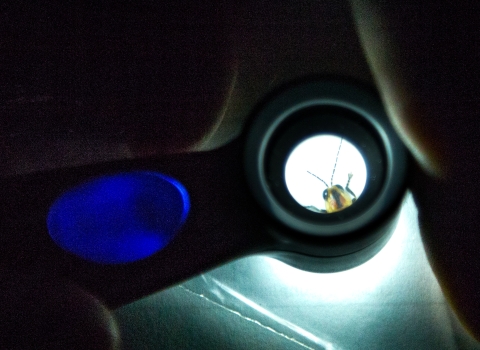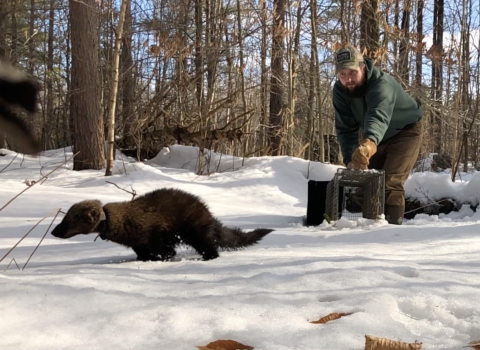It’s hard to imagine what our streams and rivers looked like 250 years ago. Factor in the millions of aquatic barriers built across the country and it’s nearly impossible. But fish passage fish passage
Fish passage is the ability of fish or other aquatic species to move freely throughout their life to find food, reproduce, and complete their natural migration cycles. Millions of barriers to fish passage across the country are fragmenting habitat and leading to species declines. The U.S. Fish and Wildlife Service's National Fish Passage Program is working to reconnect watersheds to benefit both wildlife and people.
Learn more about fish passage projects in Indiana are demonstrating just how resilient our aquatic ecosystems are. Centuries of fragmentation can be reversed in a matter of months, proving the importance of free-flowing rivers.
Indiana has a lengthy history of dam construction and usage. Many date back to European settlers in the 19th century who relied on the provided energy for grinding grain, powering sawmills, and in some cases, electricity. While these dams were historically important for early settlements, most remnant dams continue to block fish migration, fragment rivers, and pose significant hazards to humans through increased drowning risk. Removing dams that no longer provide a service to the community have proven time and time again what we all gain when we give space back to nature.
An excellent example of fish passage project success is the Eel River. The Eel River flows through farmland in Northern Indiana and is a vital habitat to a wide variety of freshwater fish and mussels. There were once 14 dams blocking fish passage in the Eel River, almost all of them unused and outdated. Thanks to hard work and collaboration with U.S. Fish and Wildlife Service partner Ecosystems Connection Institute, nearly 750 stream miles in the Eel River basin have been reopened, reconnecting the Eel River with the Wasbash and larger Mississippi River for the first time in over 200 years. Two projects- the Stockdale Mill Dam fish ladder and Logansport Dam removal- are prime examples of what fish passage projects do for aquatic ecosystems and those who rely on them.
In with the New
While the best solution for migrating fish is to remove dams completely, sometimes it’s not possible. The Stockdale Mill Dam is a historic and popular tourism site of cultural value that could not be removed. The next best option for fish passage is installing a fish ladder. However, most traditional fish ladders are built for larger jumping species and wouldn’t be appropriate for some Eel River residents like darters and shiners. Enter the Kynard Alternating Side Baffle Fish Ladder (KASBFL), an innovative structure structure
Something temporarily or permanently constructed, built, or placed; and constructed of natural or manufactured parts including, but not limited to, a building, shed, cabin, porch, bridge, walkway, stair steps, sign, landing, platform, dock, rack, fence, telecommunication device, antennae, fish cleaning table, satellite dish/mount, or well head.
Learn more about structure that not only looks pretty, but also allows passage for an incredibly diverse range of species. With this ladder, fish have space to rest while swimming against the current, making the journey accessible for fish as small as your pinky finger.
The ladder also provides monitoring opportunities to track tagged fish with sensors and set up nets for surveying at the end of the ladder. Fish were able to find and use the ladder within minutes of opening the fishway and monitoring has documented over 40 different species successfully passing the dam. Following the removal of the Logansport Dam and others along the Eel River, the number and diversity of fish presence increased. Many common species were no longer found in the Eel River due to the fragmentation of the river by the dams.
In addition to the fish passage benefits, the KASBFL is more affordable and easier to install than traditional fish ladders, making it widely accessible across the nation. This innovative technology will change the future of fish passage.
Out with the Old
Following years of restoration work, the low-head dam in Logansport was the last piece of the puzzle to completely reopen the Eel River. There is little that can be done to predict what a river will look like after a dam is removed, especially as old as the dam at Logansport. Factors like the design of the dam, sediment release, and even changes in weather conditions can all impact the outcome of restoration. Dam removal is a multi-step process with constant monitoring and evaluation to ensure the best possible restoration outcome for the surrounding area. Historians are always on-site to keep an eye out for any historic or preserved structures. This way, any important fossils or artifacts that appear can be protected from harm. Just upstream of the Logansport Dam, the original wooden dam was found after water levels dropped and the dam was carefully removed for preservation.
As the dam is removed and more water flows through the river, the water level behind the dam starts to decrease. This exposes more riverbed and the critters living there. Dam removal is done slowly piece by piece, while biologists survey the shoreline to return any stranded animals to the river.
After a dam is removed, all that’s left to do is wait for wildlife to return. Just two years after its removal in fall of 2021, monitoring has shown the return of at least 15 new species to the Eel River. The newly exposed areas create unique habitats that can now be used by a variety of organisms such as small pools for tadpoles to grow, resting areas for birds, and some new fishing and swimming areas for the public to enjoy.
A Watershed Transformed
It wasn’t just the critters who gained some real estate from these projects. In conjunction with dam removal, the town of Logansport removed an old water treatment and coal-fired power plant on the waterfront. Both structures have sat decommissioned for a decade. In their place are now basketball and tennis courts, an outdoor gym, and picnic areas. What was once an eye sore is now a thriving recreational area for the community to use and enjoy safely. These projects revitalize the riverfront, providing more recreational opportunities and economic development in the area.
The Eel River is just one example of how fish passage projects benefit both fish and people by improving community infrastructure, reopening migration pathways, and restoring the beauty of free-flowing rivers. Since 1999, the National Fish Passage Program has worked on hundreds of projects like this one, removing over 3,400 barriers and reopening access to over 61,000 stream miles. Thanks to the Bipartisan Infrastructure Law Bipartisan Infrastructure Law
The Bipartisan Infrastructure Law (BIL) is a once-in-a-generation investment in the nation’s infrastructure and economic competitiveness. We were directly appropriated $455 million over five years in BIL funds for programs related to the President’s America the Beautiful initiative.
Learn more about Bipartisan Infrastructure Law signed in 2021, capacity for these projects has increased exponentially across the country. The Law provided an additional $200 million investment to restore rivers and rebuild community through projects like this one. To learn more, please visit the National Fish Passage Program.





